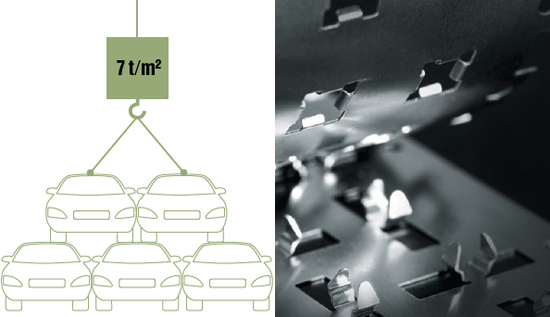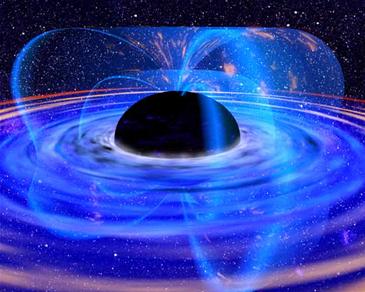A small change to the theory of gravity implies that our universe inherited its arrow of time from the black hole in which it was born.
"Accordingly, our own Universe may be the interior of a black hole existing in another universe." So concludes Nikodem Poplawski at Indiana University in a remarkable paper about the nature of space and the origin of time.
The idea that new universes can be created inside black holes and that our own may have originated in this way has been the raw fodder of science fiction for many years. But a proper scientific derivation of the notion has never emerged.
Today Poplawski provides such a derivation. He says the idea that black holes are the cosmic mothers of new universes is a natural consequence of a simple new assumption about the nature of spacetime.
Poplawski points out that the standard derivation of general relativity takes no account of the intrinsic momentum of spin half particles. However there is another version of the theory, called the Einstein-Cartan-Kibble-Sciama theory of gravity, which does.
This predicts that particles with half integer spin should interact, generating a tiny repulsive force called torsion. In ordinary circumstances, torsion is too small to have any effect. But when densities become much higher than those in nuclear matter, it becomes significant. In particular, says Poplawski, torsion prevents the formation of singularities inside a black hole.
That's interesting for a number of reasons. First, it has important implications for the way the Universe must have grown when it was close to its minimum size.
Astrophysicists have long known that our universe is so big that it could not have reached its current size given the rate of expansion we see now. Instead, they believe it grew by many orders of magnitude in a fraction of a second after the Big Bang, a process known as inflation.
The problem with inflation is that it needs an additional theory to explain why it occurs and that's ugly. Poplawski's approach immediately solves this problem. He says that torsion caused this rapid inflation.
That means the universe as we see it today can be explained by a single theory of gravity without any additional assumptions about inflation.
Another important by-product of Poplawski's approach is that it makes it possible for universes to be born inside the event horizons of certain kinds of black hole. Here, torsion prevents the formation of a singularity but allows a HUGE energy density to build up, which leads to the creation of particles on a massive scale via pair production followed by the expansion of the new universe.
This is a Big Bang type event. "Such an expansion is not visible for observers outside the black hole, for whom the horizon's formation and all subsequent processes occur after infinite time," says Poplawski.
For this reason, the new universe is a separate branch of space time and evolves accordingly.
Incidentally, this approach also suggests a solution to another of the great problems of cosmology: why time seems to flow in one direction but not in the other, even though the laws of physics are time symmetric.
Poplawski says the origin of the arrow of time comes from the asymmetry of the flow of matter into the black hole from the mother universe. "The arrow of cosmic time of a universe inside a black hole would then be fixed by the time-asymmetric collapse of matter through the event horizon," he says.
In other words, our universe inherited its arrow of time from its mother.
He says that daughter universes may inherit other properties from their mothers, implying that it may be possible to detect these properties, providing an experimental proof of his idea.
Theories of everything don't get much more ambitious than this. Entertaining stuff!
Ref: arxiv.org/abs/1007.0587: Cosmology With Torsion - An Alternative To Cosmic Inflation











Comments
"Accordingly, our own Universe may be the interior of a black hole existing in another universe." So concludes Nikodem Poplawski at Indiana University in a remarkable paper about the nature of space and the origin of time."
Wow. The only thing remarkable about Nikodem Poplawski's paper is that such pseudoscientific hogwash can originate from an institution of higher learning in this day and age. I say, shame on the University of Indiana. The very idea of a black hole is based on the concept of continuity, an idea that is not only illogical (it leads to an infinite regress), but is not even scientific in the Popperian sense of falsification. Even Einstein, Mr. Continuity himself, had doubts about continuity.
Worst of all is the idea that somehow time has a direction of flow, i.e., an arrow. The idea that we are moving in time in one direction or another is a conceptual disaster. Why? Because time cannot change by definition. This is the reason that Karl Popper called spacetime "Einstein's block universe in which nothing happens" (source: Conjectures and Refutations). Absolutely nothing can move in spacetime for this reason. Why isn't Poplawski aware of this fact and how did his Star-Trek voodoo physics paper pass peer review? This is truly a sad commentary on the state of modern physics. This stuff is not even wrong.
The problem with the physics community is that theirs is an incestuous science that has been spawning hideous monstrosities for some time now. Their bunker mentality (the public is stupid and is the enemy) prevents them from considering other points of view, especially views that contradict their worldview. They have completely abandoned the search for a foundational understanding of nature and they insist on building up on their erroneous assumptions. Physicists do not even understand motion and yet they feel confident enough to create all sorts of silliness like wormholes, multiple universes and time travel. How dare they think that they are qualified to teach us about the origin of the universe when they are wallowing in ignorance about the most basic aspects of the universe?
Ask a physicist to explain why two bodies in relative inertial motion remain in motion and you'll come face to face with abject ignorance. Vast and profound ignorance is the norm in the physics community.
Let me add that I am deeply disappointed that publications like TR are still printing such pseudoscientific fairy tales under the banner of legitimate science. Paul Feyrabend was right when he wrote in Against Method, "[...]the most stupid procedures and the most laughable results in their domain are surrounded with an aura of excellence. It is time to cut them down in size, and to give them a more modest position in society." He might as well have been writing about physicists like Nikodem Poplawski.
Who will rise up to deliver us from this mountain of crap?